Fission Stories #194
The Nuclear Regulatory Commission (NRC) has two formal programs for its workers to use when they disagree with the agency’s decisions and positions. (These programs complement informal processes where workers can discuss issues with supervisors and colleagues.) One is called the Non-Concurrence process and the other is the Differing Professional Opinion program. How free do NRC staff feel to use these?
The Non-Concurrence process can be used by NRC workers assigned to formally review and comment on draft documents being prepared by the agency. Fig. 1 shows the reviewer block for the NRC report issued last year following its component design basis inspection at the Oconee nuclear plant in South Carolina. The draft report was reviewed by ten NRC inspectors and supervisors (three individuals reviewed it twice for a total of 13 signatures). The review block indicates who reviewed the draft and when they signed their approvals. Had any individual disagreed with the draft and not been satisfied with how his or her disagreements were resolved, the review block would have contained the individual’s name but indicated non-concurrence rather than approval. And the individual would have filled out the Non-Concurrence form to trigger a formal written response by the agency.
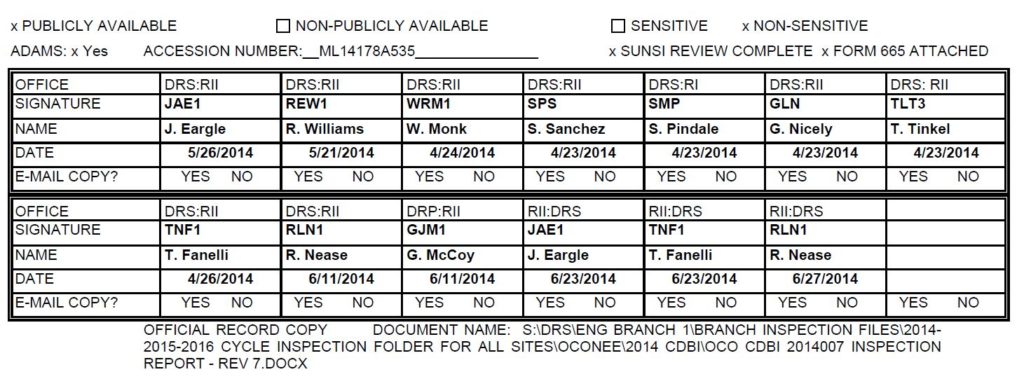
Fig. 1 (click to enlarge) (Source: NRC)
The Differing Professional Opinion (DPO) program can be used when a worker disagrees with an agency decision or position outside of document review process. For example, if an NRC inspector not involved in the Oconee inspection yet disagreeing with the NRC’s inspection report would not be able to use the Non-Concurrence process but could initiate a DPO. In addition, if a worker is not satisfied with the NRC’s formal response to his or her Non-Concurrence, that worker could initiate a DPO.
Survey results
The NRC’s Office of the Inspector General periodically surveys the NRC work force on a wide range of workplace issues, including DPOs and Non-Concurrences. The three most recent surveys were conducted in 2005, 2009, and 2012. A total of 2,269 workers responded to the 2005 survey, 3,404 workers responded to the 2009 survey, and 2,981 workers responded to the 2012 survey.
The survey results indicates that a large and growing percentage of the NRC work force is aware of the DPO and Non-Concurrence options, from 82% in 2005 to 91% in 2012.
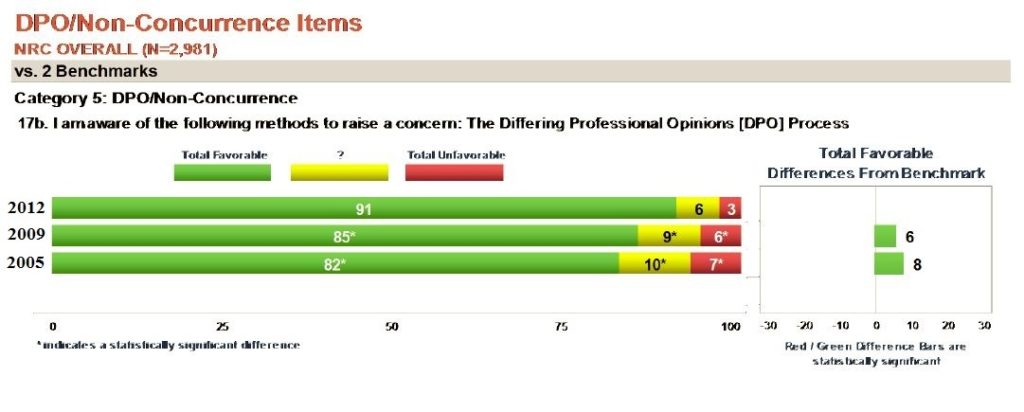
Fig. 2 (click to enlarge) (Source: NRC)
The survey results indicate a smaller majority of the work force would be willing to use the DPO program. (This area was not probed during the 2005 survey.) A small but steady portion of the work force (15%) would not use the DPO program.
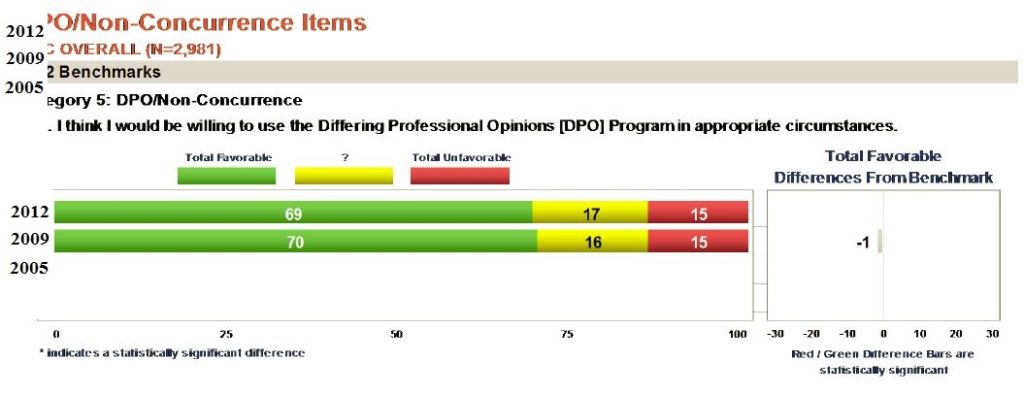
Fig. 3 (click to enlarge) (Source: NRC)
A slight majority of the work force believes the DPO program is effective. (This area was not probed during the 2005 survey). Nearly half the NRC’s work force isn’t sure if it is effective or seems certain it is not.
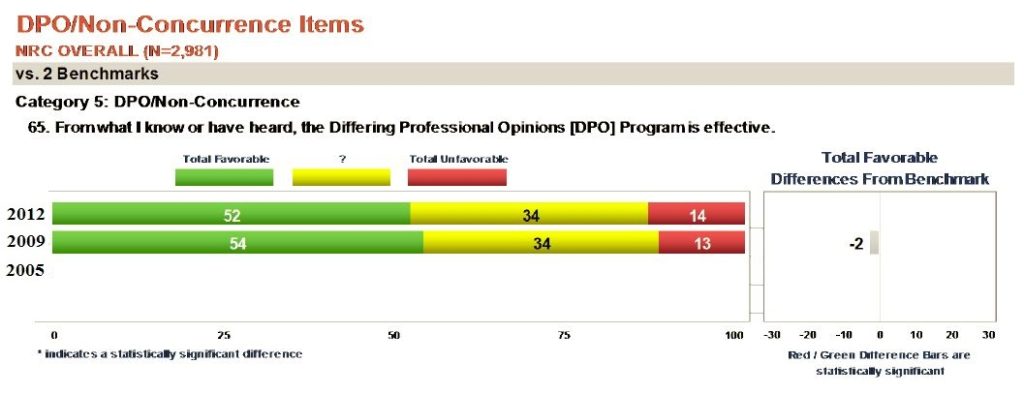
Fig. 4 (click to enlarge) (Source: NRC)
A minority but growing percentage of the work force feels the DPO program is functioning properly. Most of the work force is unsure and about 10% have steadily felt the program wasn’t functioning properly.
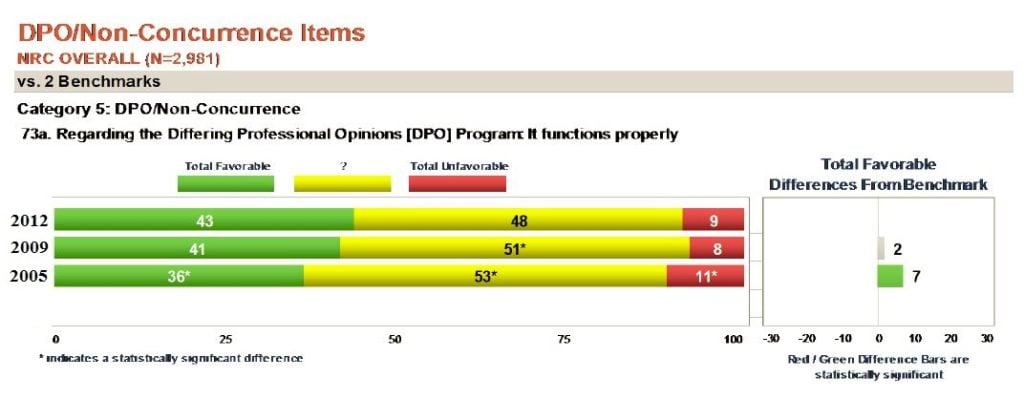
Fig. 5 (click to enlarge) (Source: NRC)
A smaller minority of the NRC’s work force believes that using the DPO program will have no negative effect on one’s career with the agency. Nearly one-fifth of the work force believes that using the DPO program will have negative repercussions.
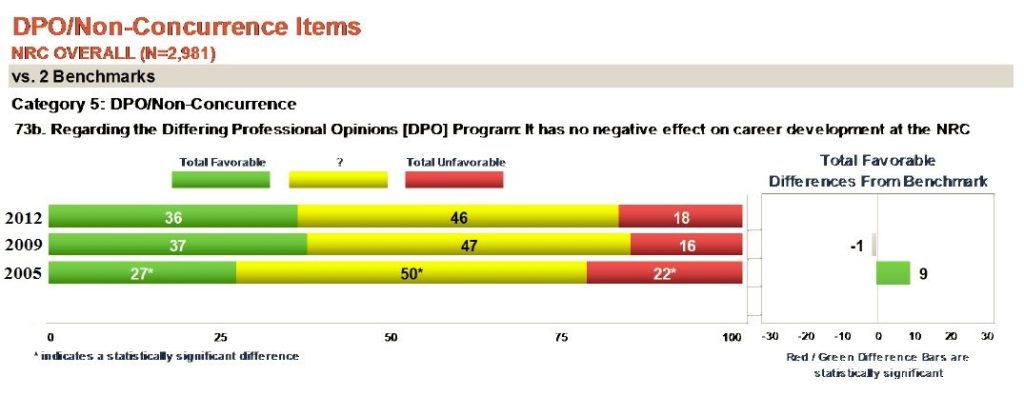
Fig. 6 (click to enlarge) (Source: NRC)
Only 61% of the NRC’s work force feels the agency has a climate workers can take truth (not necessarily a differing viewpoint but the basic, fundamental truth) up the chain of command without fear of reprisal.
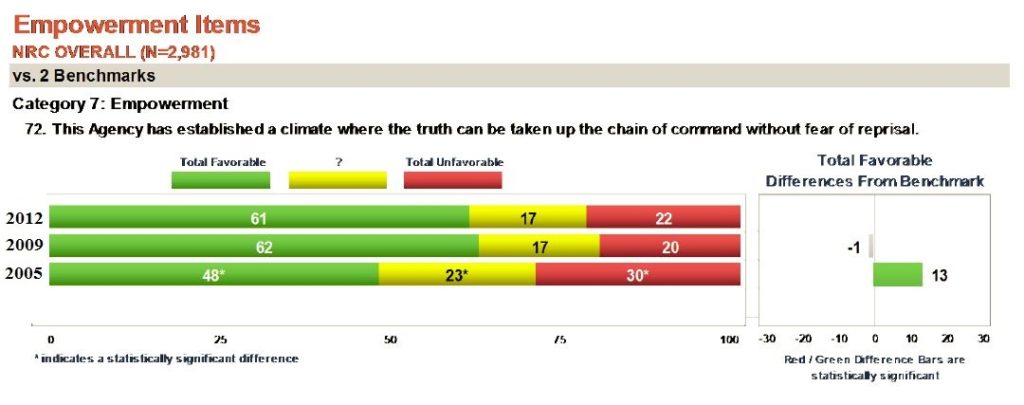
Fig. 7 (click to enlarge) (Source: NRC)
Our Takeaway
I’m gobsmacked by the survey results—and I don’t gobsmack easily (especially after learning what the word means).
In February 2002, workers discovered significant degradation of the reactor vessel head at the Davis-Besse nuclear plant. By late 2003, the damaged head had been replaced and other hardware fixes had been completed. But the NRC did not permit the reactor to be restarted because the company had not yet made sufficient progress restoring a proper safety culture. The reactor remained shut down until the spring of 2004.
The plant’s owner retained a third-party to survey its work force similar to how a third-party surveyed the NRC’s work force. The results are remarkably similar:
- 70% of the Davis-Besse work force felt free to raise concerns to management (69% of the NRC’s work force is willing to use the DPO and Non-Concurrence programs).
- 21% of the Davis-Besse work force disagreed that management did not tolerate retaliation for raising concerns (18% of the NRC’s work force feels that raising a concern would have negative career implications).
- 67% of the Davis-Besse work force believed management wanted concerns reported and willingly listens to problems (61% of the NRC’s work force believes management wants to hear the truth.)
The NRC’s survey results also closely resemble survey results from other troubled sites (e.g, Millstone in the 1997-1999 timeframe and Salem/Hope Creek in 2004-2005).
But there’s a huge difference.
NRC made the owners of Millstone, Davis-Besse and Salem/Hope Creek resolve their identified safety culture shortcomings. The NRC only needs to re-survey their work force every few years without lifting a finger about its problems.
39 out of 100 NRC workers do not believe they can take truth up the chain of command.
I am gobsmacked—and that’s the truth.
“Fission Stories” is a weekly feature by Dave Lochbaum. For more information on nuclear power safety, see the nuclear safety section of UCS’s website and our interactive map, the Nuclear Power Information Tracker.
